How to remove chair cane spline is one of the first things you must know when restoring a broken cane webbing chair seat. Use these simple directions to show you how and you’ll be a pro in no time.
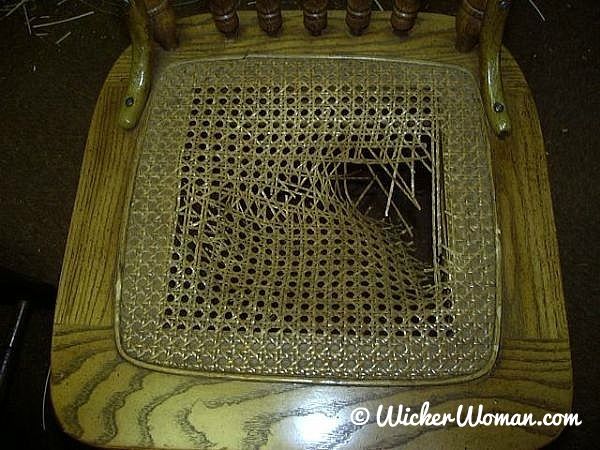
Repairing and replacing sheet cane, machine woven cane, cane webbing or removing chair spline (as it’s sometimes called), is one of the easiest types of seatweaving techniques to master. But one step in the process might cause you great frustration–removing stubborn reed spline from the groove!
Follow these three simple directions with the step-by-step photos to gain confidence enough to tackle the project yourself!
***Need to purchase materials, tools and other caning supplies? Buy from these reputable retail businesses listed on my National Cane and Basket Supplies Directory™ page.***
Many links on this website are affiliate links, which means if you click my link and then purchase an item, I receive a small commission at no extra cost to you.
Assemble Necessary Tools
Having the correct tools for the job will make this task easier and more pleasant, so be sure to have on hand:
- utility knife, white glue or hide glue (not yellow carpenter’s glue, super glue or Gorilla glue)
- wooden caning wedges (available through the cane & basket supply companies)
- special spline removal chisel of correct width to fit into the groove, & basketweaving scissors
- these tools also: a squeeze bottle, white vinegar, good sharp electric drill and drill bits, and maybe a Dremel tool with attachments, upholstery tacks & hammer or regular hammer and sandpaper.
Step One: Removing the Old Cane & Spline
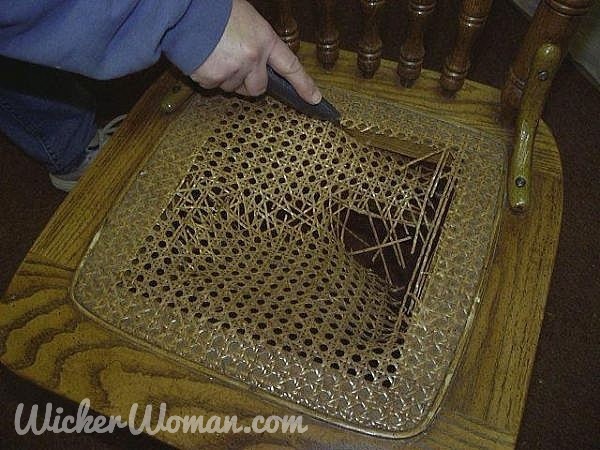
With your utility knife or scissors cut out the old chair cane webbing in the center of the seat to get it out of your way. Take care you don’t accidentally damage the surrounding wood of the chair seat with your knife while removing the cane and spline.
Then, using your utility knife with a new, sharp blade, score around both the inside and outside edges of the groove, on either side of the reed spline that you will be removing.
Be sure to go all around the chair seat when you score, not just part way. This loosens the varnish or paint that might be on the chair, as well as loosening some of the glue inside the groove.
Step Two: Loosen and Pry up the Spline
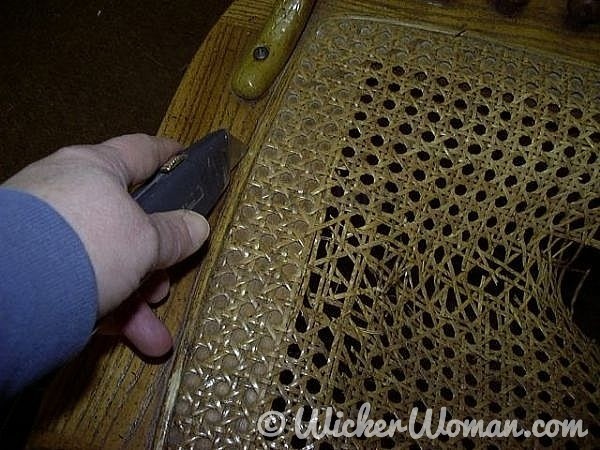
If you are working on a round seat you will begin removing the spline at the back where the butt ends of the spline meet. If you are working on a trapezoidal seat with mitered corners, start on the front rail, so as not to damage the corners of the chair frame. Just cut into the spline using the sharp chisel, tapping with the hammer.
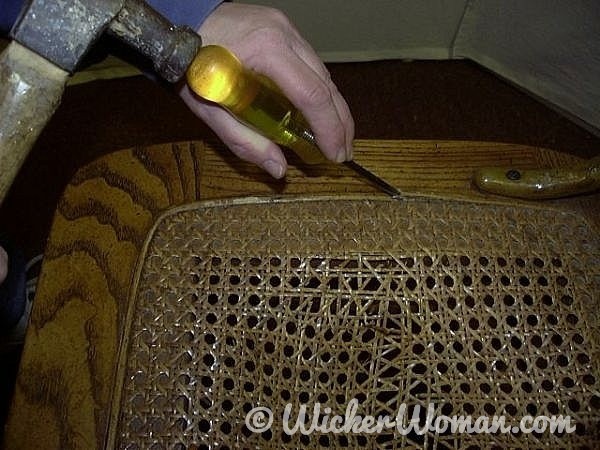
Using the special caning chisel inserted into the spline, using an upward rocking motion, begin prying up the spline. Lightly tap on the end of the chisel with your hammer to help force along.
Sometimes, if you are lucky, the entire spline will come out in one motion, but more likely it will come out in small pieces. So, take your time and don’t rush the process.
Step Three: Cleaning the Groove
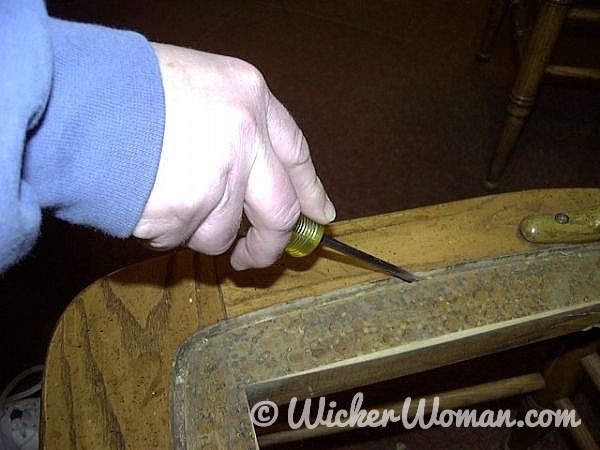
Clean out any remaining cane and glue from the groove using your utility knife, the hammer and chisel, sandpaper, and/or Dremel tool attachment. You must remove all traces of the old glue because the new glue won’t adhere to old glue.
After all the old cane and spline are completely cleaned out of the groove, sand the rough edges on both the inside and outside of the groove. This will help to prevent the new cane from breaking after it’s installed.
Final Touches
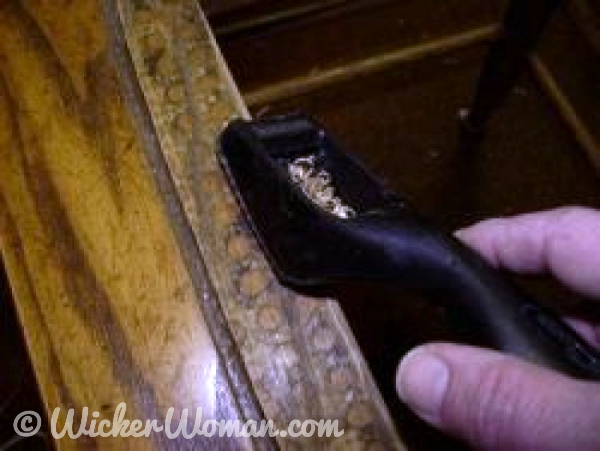
It’s also a good idea to use a rasp or Stanley Sure-Shaver to bevel (round off) the inside edge of the chair seat frame, before installing the new cane and spline. Then, smooth both the groove and the sharp chair seat frame edge with sandpaper.
If the sharp 90º edges are not rounded off, then they might cut the new sheet cane after the seat has been used for a while.
Because as people begin sitting on the cane seat, the cane will begin to sag, and as it does, the sharp edges may cut the cane, thereby damaging the cane and requiring the seat to be replaced sooner than necessary.
RELATED READING: How to Care for Your Cane Furniture
REMOVING STUBBORN SPLINE-ADDITIONAL TIPS
If your spline and cane just will not come out of the groove, you will need to take more drastic measures by using an electric drill, warm white vinegar, or denatured alcohol to loosen the glue in the groove.
Step One: Drill Holes in Spline
- With your electric drill and a 1/8″ – 3/16″ drill bit (I use Brad Point Bits with the sharp point), drill several small holes spaced about 4-6″ apart around the entire length of the spline. The depth of the drilled holes should probably be no greater than about 1/4″ – 1/2″, depending on the depth of the groove, however.
- You want to go through the spline, so the solvent will dissolve the glue, but not so deep as to go into the wood framework itself, which is right below the spline under the cane.
Step Two: Add Glue Solvent
- Fill your squeeze bottle with either warm white vinegar or denatured alcohol (but NOT both). Carefully squeeze the liquid into the predrilled holes and along both the inner and outer sides of the groove.
- Let the solvent soak in the holes for 20 minutes – 2 hours to soften the glue.
- This will loosen the glue in the groove making it easier to remove, but it also makes quite a mess, so take care not to damage the finish on the seat.
Step Three: Pry Up and Remove Spline
- After using the solvent in the groove and it has soaked in a considerable amount of time, to loosen, pry up. Score around the edges of the spline again first and pry up the end with an awl or your caning chisel to begin removal.
- Usually the best place to start is in the center where the two spline ends meet of a round seat.
- In the case of mitered corners, begin at one of the drilled holes in the center along a rail, front or back or in one of the holes. The mitered corners are easily damaged, so don’t start there with the chisel.
- Using your hammer, tap lightly on the head of the chisel that’s been inserted between the spline and the bottom of the groove.
- Gently rock the chisel up and down, prying the spline up and out of the groove in short pieces.
- Be sure to get your chisel under the cane, which is under the spline so that it too, will be removed.
Step Four: Clean the Groove Completely
- When you’ve gotten all the old glue, spline, and remaining bits of cane out of the groove (from both bottom and sides), scrape it clean. Use the tip of the chisel (or another scraping tool) and use your utility knife for the inside walls.
- When the groove has dried completely, go over it again to clean it up using coarse sandpaper, smoothing off the rough edges. Here’s where a Dremel tool with its special attachments might speed up the process.
- Be sure to also bevel the inside edge of the entire groove with a rasp, utility knife, Dremel tool or Sure-Form Shaver so the edge will not cut the new sheet cane.
Congrats! You’re all done removing the spline! Now follow these how-to instructions to install cane webbing in your chair!
RELATED READING: How to insert cane webbing like a pro!
Alternative method to remove cane spline–Use a steamer!
Here’s a video of Debbie Kinghan from California demonstrating using a steamer machine to remove the chair cane spline and webbing. This demonstration was presented in 2008 for the members of The SeatWeavers’ Guild, Inc.® at our second annual Gathering in Nelsonville, Ohio.
Hope this FREE “How-to Remove Chair Cane Spline” article has been of help to you today. And thank you very much for your kind donation to help support us so we can provide more “How-to” articles for you!
Check out all the How-to Videos by Cathryn for more hints and tips on Chair Caning Tips, Antique Wicker, Antler Baskets and more!
Come back soon to see more updates and article additions to WickerWoman.com!

<–Back to FREE Articles, Tip Sheets, Reports
Next to–> How-to Remove Chair Cane Webbing
